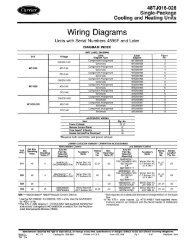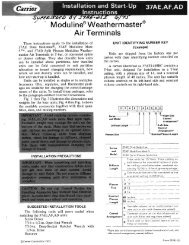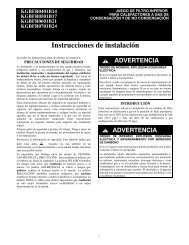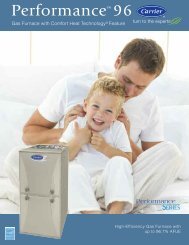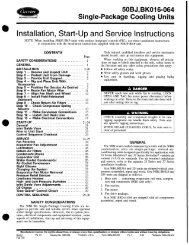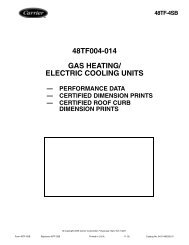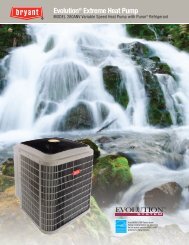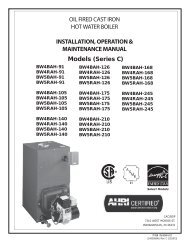Start-Up, Operation, and Maintenance Instructions
Start-Up, Operation, and Maintenance Instructions
Start-Up, Operation, and Maintenance Instructions
You also want an ePaper? Increase the reach of your titles
YUMPU automatically turns print PDFs into web optimized ePapers that Google loves.
2. Evacuate the refrigerant gas from the chiller condenser<br />
vessel.<br />
a. Access the PUMPDOWN LOCKOUT function<br />
accessed from the CVC/ICVC CONTROL TEST<br />
table to turn on the chiller water pumps. Turn the<br />
chiller water pumps on manually if they are not<br />
controlled by the PIC II.<br />
b. Close pumpout unit valves 3 <strong>and</strong> 4; open valves 2<br />
<strong>and</strong> 5.<br />
VALVE 1a 1b 2 3 4 5 8 11 12 13 14<br />
CONDITION C C C C C C C<br />
c. Turn on the pumpout condenser water.<br />
d. Run the pumpout compressor until the chiller<br />
condenser pressure reaches 18 in. Hg vac (40 kPa<br />
abs.). Monitor pressure at the CVC/ICVC <strong>and</strong> at<br />
refrigerant gages.<br />
e. Close valve 1b.<br />
f. Turn off the pumpout compressor.<br />
g. Close valves 1a, 2, <strong>and</strong> 5.<br />
VALVE 1a 1b 2 3 4 5 8 11 12 13 14<br />
CONDITION C C C C C C C C C C C<br />
h. Turn off the pumpout condenser water.<br />
i. Proceed to the PUMPDOWN LOCKOUT test<br />
from the CVC/ICVC CONTROL TEST table to<br />
turn off the chiller water pumps <strong>and</strong> lock out the<br />
chiller compressor. Turn off the chiller water<br />
pumps manually if they are not controlled by the<br />
PIC II.<br />
RETURN CHILLER TO NORMAL OPERATING<br />
CONDITIONS<br />
1. Ensure vessel that was opened has been evacuated.<br />
2. Access the TERMINATE LOCKOUT function CVC/<br />
ICVC from the CONTROL TEST table to view vessel<br />
pressures <strong>and</strong> turn on chiller water pumps. If the chiller<br />
water pumps are not controlled by the PIC II, turn them<br />
on manually.<br />
3. Open valves 1a, 1b, <strong>and</strong> 3.<br />
VALVE 1a 1b 2 3 4 5 8 11 12 13 14<br />
CONDITION C C C C C C C C<br />
4. Slowly open valve 5, gradually increasing pressure in the<br />
evacuated vessel to 35 psig (141 kPa). Feed refrigerant<br />
slowly to prevent tube freeze up.<br />
5. Leak test to ensure vessel integrity.<br />
6. Open valve 5 fully.<br />
VALVE 1a 1b 2 3 4 5 8 11 12 13 14<br />
CONDITION C C C C C C C<br />
7. Open valve 11 to equalize the liquid refrigerant level between<br />
the vessels.<br />
8. Close valves 1a, 1b, 3, <strong>and</strong> 5.<br />
9. Open isolation valves 12, 13, <strong>and</strong> 14 (if present).<br />
VALVE 1a 1b 2 3 4 5 8 11 12 13 14<br />
CONDITION C C C C C C C<br />
10. Proceed to the TERMINATE LOCKOUT screen (accessed<br />
from the CONTROL TEST table) to turn off the water<br />
pumps <strong>and</strong> enable the chiller compressor for start-up. If<br />
the chiller water pumps are not controlled by the PIC II,<br />
turn them off manually.<br />
71<br />
GENERAL MAINTENANCE<br />
Refrigerant Properties — The st<strong>and</strong>ard refrigerant for<br />
the 19XR chiller is HFC-134a. At normal atmospheric pressure,<br />
HFC-134a will boil at –14 F (–25 C) <strong>and</strong> must, therefore,<br />
be kept in pressurized containers or storage tanks. The refrigerant<br />
is practically odorless when mixed with air <strong>and</strong> is noncombustible<br />
at atmospheric pressure. Read the Material Safety<br />
Data Sheet <strong>and</strong> the latest ASHRAE Safety Guide for Mechanical<br />
Refrigeration to learn more about safe h<strong>and</strong>ling of this<br />
refrigerant.<br />
HFC-134a will dissolve oil <strong>and</strong> some nonmetallic materials,<br />
dry the skin, <strong>and</strong>, in heavy concentrations, may displace<br />
enough oxygen to cause asphyxiation. When<br />
h<strong>and</strong>ling this refrigerant, protect the h<strong>and</strong>s <strong>and</strong> eyes <strong>and</strong><br />
avoid breathing fumes.<br />
Adding Refrigerant — Follow the procedures described<br />
in Trim Refrigerant Charge section, page 72.<br />
Always use the compressor pumpdown function in the<br />
Control Test table to turn on the cooler pump <strong>and</strong> lock out<br />
the compressor when transferring refrigerant. Liquid refrigerant<br />
may flash into a gas <strong>and</strong> cause possible freeze-up<br />
when the chiller pressure is below 30 psig (207 kPa) for<br />
HFC-134a.<br />
Removing Refrigerant — If the optional pumpout system<br />
is used, the 19XR refrigerant charge may be transferred to<br />
a pumpout storage tank or to the chiller condenser or cooler<br />
vessels. Follow the procedures in the Pumpout <strong>and</strong> Refrigerant<br />
Transfer Procedures section when transferring refrigerant from<br />
one vessel to another.<br />
Adjusting the Refrigerant Charge — If the addition<br />
or removal of refrigerant is required to improve chiller performance,<br />
follow the procedures given under the Trim Refrigerant<br />
Charge section, page 72.<br />
Refrigerant Leak Testing — Because HFC-134a is<br />
above atmospheric pressure at room temperature, leak testing<br />
can be performed with refrigerant in the chiller. Use an electronic<br />
halide leak detector, soap bubble solution, or ultrasonic<br />
leak detector. Ensure that the room is well ventilated <strong>and</strong> free<br />
from concentration of refrigerant to keep false readings to a<br />
minimum. Before making any necessary repairs to a leak,<br />
transfer all refrigerant from the leaking vessel.<br />
Leak Rate — It is recommended by ASHRAE that chillers<br />
be taken off line immediately <strong>and</strong> repaired if the refrigerant<br />
leak rate for the entire chiller is more than 10% of the operating<br />
refrigerant charge per year.<br />
In addition, Carrier recommends that leaks totalling less<br />
than the above rate but more than a rate of 0.1% of the total<br />
charge per year should be repaired during annual maintenance<br />
or whenever the refrigerant is transferred for other service<br />
work.<br />
Test After Service, Repair, or Major Leak — If<br />
all the refrigerant has been lost or if the chiller has been opened<br />
for service, the chiller or the affected vessels must be pressure<br />
tested <strong>and</strong> leak tested. Refer to the Leak Test Chiller section to<br />
perform a leak test.







